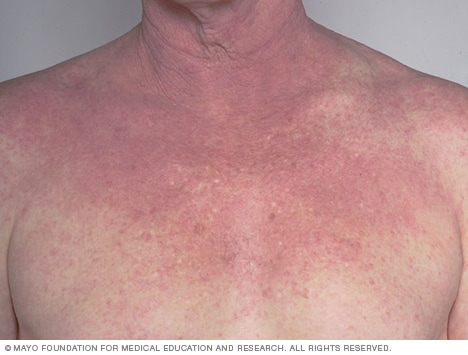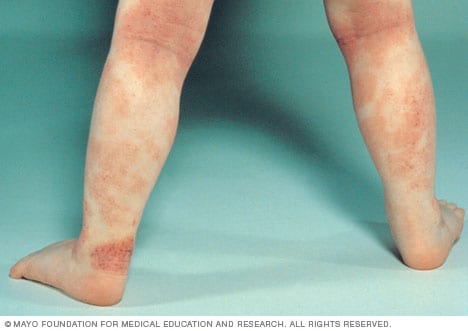Atopic Dermatitis (AD)
An Atopic Dermatitis (AD) is a dermatitis that is a long-term skin inflamation.
- AKA: Atopic Eczema, Infantile Eczema, Prurigo Besnier, Allergic Eczema, Neurodermatitis.
- Context:
- It can be a Chronic Skin Disease.
- Example(s):
- atopic dermatitis on the chest:

- atopic dermatitis on the legs:

- …
- atopic dermatitis on the chest:
- Counter-Example(s):
- See: Eczema, Dermatology, Immunology, Pruritus, Skin Infection, Hay Fever, Asthma, Family History (Medicine), Contact Dermatitis, Psoriasis, Seborrheic Dermatitis, Moisturising Cream.
References
2022
- (Wikipedia, 2022) ⇒ https://en.wikipedia.org/wiki/Atopic_dermatitis Retrieved:2022-3-9.
- Atopic dermatitis (AD), also known as atopic eczema, is a long-term type of inflammation of the skin (dermatitis).[1] It results in itchy, red, swollen, and cracked skin. Clear fluid may come from the affected areas, which often thickens over time. While the condition may occur at any age, it typically starts in childhood, with changing severity over the years. In children under one year of age, much of the body may be affected.[2] As children get older, the areas on the insides of the knees and elbows are most commonly affected. In adults, the hands and feet are most commonly affected. Scratching the affected areas worsens the symptoms, and those affected have an increased risk of skin infections. Many people with atopic dermatitis develop hay fever or asthma.
The cause is unknown but believed to involve genetics, immune system dysfunction, environmental exposures, and difficulties with the permeability of the skin. If one identical twin is affected, the other has an 85% chance of having the condition. Those who live in cities and dry climates are more commonly affected. Exposure to certain chemicals or frequent hand washing makes symptoms worse. While emotional stress may make the symptoms worse, it is not a cause. The disorder is not contagious. A diagnosis is typically based on the signs and symptoms. Other diseases that must be excluded before making a diagnosis include contact dermatitis, psoriasis, and seborrheic dermatitis. Treatment involves avoiding things that make the condition worse, daily bathing with application of a moisturising cream afterwards, applying steroid creams when flares occur, and medications to help with itchiness. Things that commonly make it worse include wool clothing, soaps, perfumes, chlorine, dust, and cigarette smoke. Phototherapy may be useful in some people. Steroid pills or creams based on calcineurin inhibitors may occasionally be used if other measures are not effective. [3] Antibiotics (either by mouth or topically) may be needed if a bacterial infection develops. Dietary changes are only needed if food allergies are suspected. Atopic dermatitis affects about 20% of people at some point in their lives. [4] It is more common in younger children. Males and females are equally affected. Many people outgrow the condition. Atopic dermatitis is sometimes called eczema, a term that also refers to a larger group of skin conditions. Other names include "infantile eczema", "flexural eczema", "prurigo Besnier", "allergic eczema", and "neurodermatitis".
- Atopic dermatitis (AD), also known as atopic eczema, is a long-term type of inflammation of the skin (dermatitis).[1] It results in itchy, red, swollen, and cracked skin. Clear fluid may come from the affected areas, which often thickens over time. While the condition may occur at any age, it typically starts in childhood, with changing severity over the years. In children under one year of age, much of the body may be affected.[2] As children get older, the areas on the insides of the knees and elbows are most commonly affected. In adults, the hands and feet are most commonly affected. Scratching the affected areas worsens the symptoms, and those affected have an increased risk of skin infections. Many people with atopic dermatitis develop hay fever or asthma.
- ↑ "Handout on Health: Atopic Dermatitis (A type of eczema)". National Institute of Arthritis and Musculoskeletal and Skin Diseases. May 2013. Archived from the original on 30 May 2015. Retrieved 19 June 2015.
- ↑ Tollefson MM, Bruckner AL (December 2014). "Atopic dermatitis: skin-directed management". Pediatrics. 134 (6): e1735–44. doi:10.1542/peds.2014-2812. PMID 25422009.
- ↑ Carr WW (August 2013). "Topical calcineurin inhibitors for atopic dermatitis: review and treatment recommendations". Paediatric Drugs. 15 (4): 303–10. doi:10.1007/s40272-013-0013-9. PMC 3715696. PMID 23549982.
- ↑ Thomsen SF (2014). "Atopic dermatitis: natural history, diagnosis, and treatment". ISRN Allergy. 2014: 354250. doi:10.1155/2014/354250. PMC 4004110. PMID 25006501.
2019
- (Nao et al., 2019) ⇒ Chan H. Nao, Janice Chung, and Eric L. Simpson. (2019). “Quality of Life and Disease Impact of Atopic Dermatitis and Psoriasis on Children and their Families.” Children 6, no. 12
- QUOTE: Atopic dermatitis (AD) and psoriasis are common chronic skin diseases affecting children. These disorders negatively impact the quality of life (QoL) of patients in health-related aspects such as physical, psychosocial, and mental functioning. ...

- QUOTE: Atopic dermatitis (AD) and psoriasis are common chronic skin diseases affecting children. These disorders negatively impact the quality of life (QoL) of patients in health-related aspects such as physical, psychosocial, and mental functioning. ...
2017
- (Furue & Kadono, 2017) ⇒ Masutaka Furue, and Takafumi Kadono. (2017). ““Inflammatory Skin March” in Atopic Dermatitis and Psoriasis.” Inflammation Research 66, no. 10
- QUOTE: ... Inflammatory skin diseases such as atopic dermatitis and psoriasis are an active source of diverse proinflammatory cytokines and chemokines, which are readily detectable in the circulation and are likely to be involved in developing comorbidities.
Evidence: Both atopic dermatitis and psoriasis are frequently comorbid with CVD, metabolic syndrome and autoimmune diseases, the consequence of which is called “inflammatory skin march”, “psoriatic march” or “march of psoriasis”. ...

- QUOTE: ... Inflammatory skin diseases such as atopic dermatitis and psoriasis are an active source of diverse proinflammatory cytokines and chemokines, which are readily detectable in the circulation and are likely to be involved in developing comorbidities.